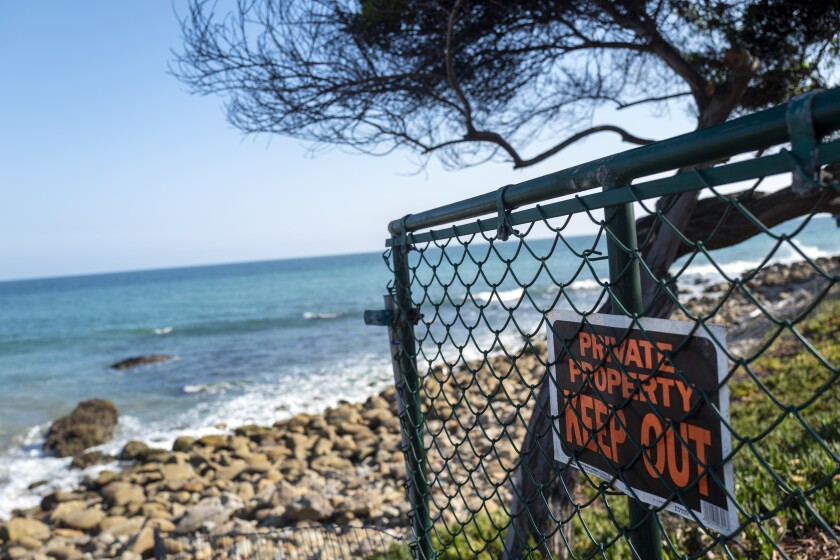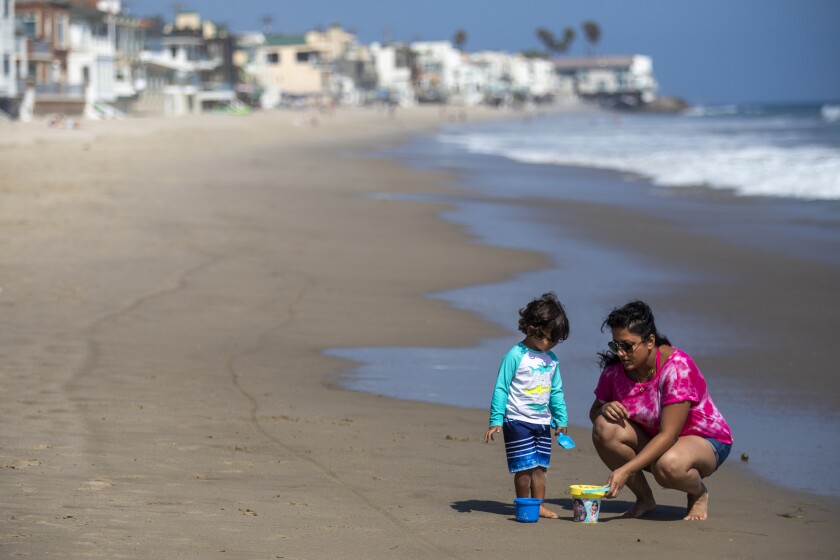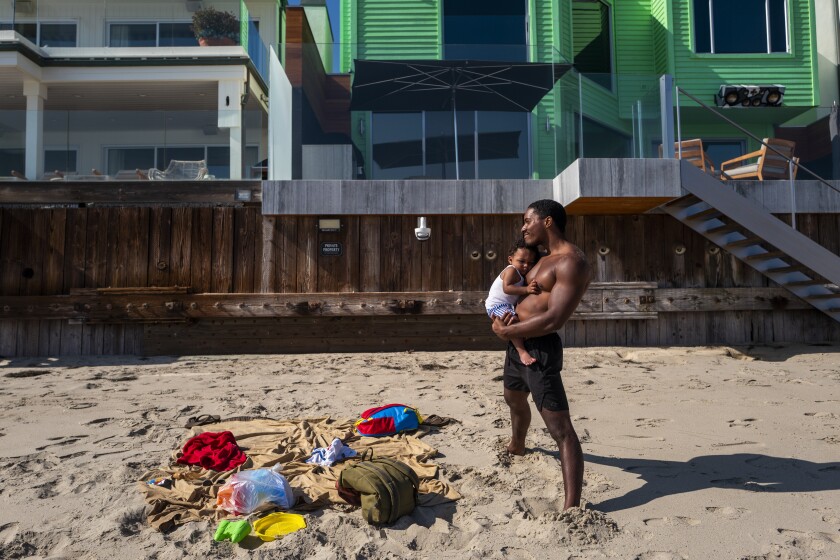The signs went up about a half-century ago, but they spring to memory like yesterday. On a white background, in vivid red lettering: “Danger” and “KEEP OUT.”
An unseen hand mounted the warnings around the top and sides of the wide concrete tunnel, an underpass built to allow tiny Coal Creek to flow under Pacific Coast Highway and into Santa Monica Bay. The subtext couldn’t have been clearer: “Stay Off Our Beach.”
That’s not the kind of message anyone wants to read. It was especially unwelcome to us, kids lucky enough to grow up in the sunbaked hills on the other side of the coast highway, in Malibu.
Half a dozen years before the California Coastal Act of 1976 made it official, something primal already assured us that access to the beach should be welcomed, not off-limits like some tycoon’s yacht. So, with a wicked old chain-link fence blocking direct access to the shore, we ignored the signs and plunged under PCH.
It was dark in there. And cramped. We had to tuck our elementary school-sized bodies into balls to creep forward.

A sign reading “keep out” adorns a gate along the beach in Malibu on Aug. 8.
(Francine Orr / Los Angeles Times)
At the end of the passage, seawater pooled, which meant wading through a mucky pond teeming with driftwood and mystery flotsam. But we got our reward. First came the sunlight, the sand and — after a scramble across a rocky point — finally, the beach. No one could claim ownership here, where pelicans swooped and dolphins played.
We called it the “Cove,” the beach where I fished and bodysurfed and snorkeled and caroused with my brother, sister, cousins and friends. In those pre-responsibility years, we idled ferociously, trying our hardest to make summer never end.
Over the decades, the small stretch of dry sand became ever smaller, reduced by rising sea levels and by construction of one more massive beachfront home. At the highest tides, the dry sand is completely submerged. Still, the Cove endured, one of the California coast’s innumerable little gems.
Then, this May, the chain-link fence that had stood for decades suddenly disappeared. What is technically the westernmost end of La Costa Beach suddenly had its front door flung open to Pacific Coast Highway and, thus, the world.
The dear old Cove had been liberated! It feels clear that something has been gained. But was something lost as well? I wanted to find out how it happened and what it meant.

Avanti Dalal and her nephew Sebastian of New Jersey play on La Costa Beach in early August.
(Francine Orr / Los Angeles Times)
::
After just a phone call or two, I found local residents in a tizzy — a lawsuit had been filed, demanding a return of the fence. One homeowner told me she registered her complaint directly with Gov. Gavin Newsom. She has his number.
Complaints and litigation seem to pop up almost every time a Malibu accessway opens, about three dozen times in recent years. To understand the latest conflict, I figured I better go back to the beginning.
A revolution arrived along the California coast in 1972, when voters approved Proposition 20, a ballot measure that grew out of concern about unchecked development. Four years later, the Legislature approved the Coastal Act, which declared a bold set of principles dedicated to environmental protection. The law also extended the life of the voter-approved California Coastal Commission, one of the nation’s most powerful land-use agencies.
But even sacrosanct values have limits. The Coastal Act requires regulators to balance public access with private property rights, while also maximizing public safety and protecting fragile ecosystems.
One thing the courts generally have agreed on: The Coastal Commission can require concessions from homeowners and other builders who impede the public’s access to the coast. That’s the principle that cleared the way for the masses to gain access to the Cove — or Carbon-La Costa Beach, as state officials call it.

Beachgoers climb down a rocky path to La Costa Beach in early August.
(Francine Orr / Los Angeles Times)
Years ago, the property was bought and given to the state Coastal Conservancy, sister agency to the Coastal Commission, by a trio of L.A. power brokers — civic titan Eli Broad, “Mighty Morphin Power Rangers” entrepreneur Haim Saban and Nancy Daly Riordan, then wife of Los Angeles Mayor Richard Riordan.
This was not an act of charity. The three luminaries planned to knock down two homes, each, along neighboring Carbon Beach (now often called Billionaire’s Beach) to erect much larger homes. In exchange for permission to build, the magnates agreed in 2000 to donate a piece of the Cove to compensate for the “visual resource” their huge homes robbed from the public.
The transfer of that property to the public felt particularly sweet to coastal access champions because ocean views have been virtually eliminated by mega-homes that stand shoulder-to-shoulder along Billionaire’s Beach. But a victory for outsiders felt to some locals like a heist, stealing their treasured privacy and security. A group of La Costa Beach homeowners, including actor Ryan O’Neill, sued the Coastal Commission.
A unanimous California Court of Appeals rejected their complaints. The court found in 2002 that the commission was well within its rights to offer “off-site mitigation.” The court suggested that improvements, like a gate limiting access to daylight hours, would help assure the beach was secure.
Yet the Cove remained blocked by that rusted, tattered fence. The Coastal Conservancy had no staff prepared to open it to the public. It took another 16 years, until 2018, for progress. That’s when the conservancy passed the lot (and an adjoining parcel purchased to widen the access) to yet another pair of state agencies.
A cumbersome approval process lumps the Cove in with 16 other Malibu accessways that need to be opened or improved. It wasn’t likely that fence would come down before 2023.
Then everything changed. Locals hired workmen to tear down the old barrier in early May and erect a new one. They said the old fence had too many holes and didn’t keep people out.

Over the decades, the small stretch of dry sand became ever smaller, reduced by rising sea levels and home construction.
(Francine Orr / Los Angeles Times)
It’s a political truism that crisis equals opportunity. And the opportunists at the Mountains Recreation and Conservation Authority (MRCA), the agency now overseeing the beach, jumped at their chance. They said that by erecting an unpermitted fence the locals effectively blocked court-ordered access to public land. They ordered the fence torn down.
::
Back in my youth, we canyon-dwellers weren’t oblivious to our advantages. But they seemed pale in comparison to the technicolor wealth and celebrity of those who lived right on the beach.
On regular walks we’d see Flip Wilson, the No. 1 TV comedian of the time, out on his deck, sometimes resplendent in a robe. O’Neill, star of the totemic movie “Love Story,” reacted with admirable restraint when our feral dog, Dingo, gave chase one day and knocked the jogging star right on his butt. We admired the graceful swimming strokes of Lloyd Bridges, of TV’s “Sea Hunt” and the “Here’s Johnny!”-madness of Jack Nicholson, bodysurfing right over the rocky point.
These outsized characters appeared terribly normal, even vulnerable, up close.
The real privilege in those days was being able to walk as a family, five abreast, up the shore. Our dogs provided constant entertainment. Dingo famously dragged driftwood logs, bigger than his own body, for a mile up the beach. Sheepdog Mugs would track home enough of the beach to fill a small sandbox. Wild Zala would roll in seaweed or a nicely aged seagull carcass. She once disappeared for a few minutes during the holiday-season, reemerging at our sides with a large ham clenched in her jaws.
Still, we felt like part of a different caste; content to live on the manor grounds, but always outside the castle gates. The “KEEP OUT” signs hung for years over our tunnel entry. When those warnings failed, the anonymous exclusionist posted new warnings that blared: “DANGER. Rattlesnakes.” Sure.
Finally, sometime after I’d moved away to college, the beach elitists surreptitiously had another chain-link fence installed across the tunnel entrance.
The fence ticked off my dad, who had worked all his life — up from next-to-nothing — to earn a spot in a place like this. Dad complained to Fire Station No. 70, stationed beside the creek, and the elitists soon learned a lesson: No matter how much you are worth, you can’t block a county flood-control channel. The firefighters ordered the fence removed. Our tiny coastal access battle had been won.
Twenty-first century beach visitors don’t need our underground entryway. With the fence down, they can get from car to surf in less than a minute.
“It’s such a beautiful resource and a place for families to go and enjoy,” said Irma Munoz, chair of the Santa Monica Mountains Conservancy, which holds title to the Cove properties. She loves how the Malibu accessways draw people from inland neighborhoods that lack open space. Many of them are working-class people of color.
Munoz founded the nonprofit Mujeres de la Tierra in part to help bring more people to these once-exclusive places. In July, Mujeres bused about 45 Latino visitors from Pacoima to Escondido Beach in central Malibu. She said she was infuriated when a local woman wanted to know if the newcomers were launching a beach cleanup; then started snapping pictures.

Shaun Fury holds his son, Zion, on La Costa Beach in early August.
(Francine Orr / Los Angeles Times)
“Just because we are people of color it doesn’t mean we have to be there to work,” said Munoz. “We were just a group of families trying to enjoy a beautiful day at the beach.”
What Munoz and her group want is what any beach visitor wants — to feel they are welcomed, or at least not made to feel like they don’t belong, on land that state law recognizes as open to everyone.
Color has for too long presented a blockade at lily-white beaches all along the coast. No doubt that’s still a noxious motivator for at least a few people who want to limit access to the shore.
But I will take the many, many locals at their word when they assured me they are good with anyone visiting La Costa Beach, as long as they follow the rules. They noted that state officials have long agreed that a daytime-only gate, trash cans and other improvements are needed. Those have yet to be installed.
::
The access wars that have flared anew this summer feel as old as the rocky point at one end of the Cove and as new as the next tide.
Some locals and an attorney assured me that the removal of the fence will bring a kind of Armageddon — malevolent outsiders running amok and wandering onto people’s private property. The coastal access activists are just as sure that more people and the treasured habitat can flourish, side by side.
“Look at all the people enjoying this,” said Margaret Shultz, from nearby Las Flores Canyon. She and husband Michael already had found ways around the old fence to go swimming. “I just think that it should belong to everyone.”
As one who enjoyed what was essentially a private beach for all those years, I understand what the locals are worried about. Humans have a way of wearing out nature. But my view is much closer to those who took the fence down. I have visited the Cove half a dozen times in recent weeks. I don’t see destruction or chaos.
I mostly see families wading in the waves and bodysurfing. I see fishermen early in the morning, catching corbina and baby leopard sharks, just as I did in the 1970s. And I see a dad being buried up to his chin in the sand by his kids, a scene doubtless as old as the Tongva settlements that once graced these shores.
When I talk to San Fernando Valley refugees, escaping another 100-degree day, it’s hard not to share their giddiness as they plop down in the moist sand, alongside Mother Nature’s timeless air conditioner.
I called Caltrans and a watch commander at the sheriff’s station. They confirmed that there has been no serious trouble around the Cove since the fence came down, though deputies have told some people to move away when they’ve planted themselves too close to (and even underneath) homes.
Visitors should know that the law doesn’t allow them to trespass under people’s homes, even for shade. Public easements allow visitors along most of the beach, but generally not within 10 feet of people’s homes.
“Just respect it. Respect it,” said Tones Gomez, a 40-something muralist who had driven out of scorching North Hollywood on a recent Saturday. “Don’t get into other people’s space. And don’t leave trash. Leave it like you found it.”
A local political activist named Jennifer deNicola gave voice to what many locals told me: They just want the public accessway to be like the other openings in the area, with trash cans, signs to lay out the ground rules, and gates that lock from sundown to sunup.
Fair enough. I would say that it’s time to get the improvements built. Quickly.
Column One
A showcase for compelling storytelling
from the Los Angeles Times.
I ventured over to the old tunnel a few days back. The creek bed is more clogged with brush, tule reeds and driftwood than ever. But the KEEP OUT signs had disappeared.
As I left the Cove recently, I met another former local, a sun-drenched 20-something named Henry Ward, who once lived right on Billionaire’s Beach. He had no problem with the fence coming down.
“This is our sanctuary, right?” Ward said. “It’s the one thing we get that shouldn’t be taken away from anyone.”
As he spoke, he stood beside a pickup truck, the stereo pumping the Beatles. It felt like the lads might as well have been right beside us: “Here comes the sun, duh, duh, duh, duh,” they sang. “Here comes the sun. . . And I say, it’s all right.”

